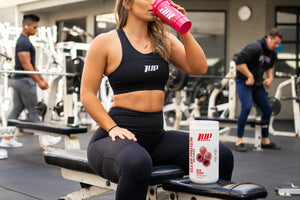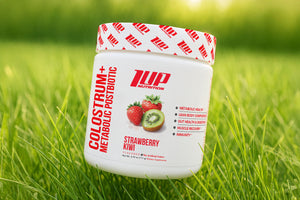Building and maintaining muscle is one of the single best things you can do for your life. Yes, it’ll help you look even more awesome than you already do in (and out) of your clothes, but that only begins to scratch the surface of the many benefits to be had from building muscle.
Let’s discuss.
7 Mind & Body Benefits of Building Muscle
#1 Increased Self-Confidence
There’s nothing quite like the sense of personal accomplishment and fulfillment that comes with completing a transformation -- setting new PRs on big lifts like squats and deadlifts, seeing toned, sleek muscle, and let’s not forget slipping into those new clothes you bought with ease.
These physical accomplishments can supercharge your self-confidence in ways that can also pay dividends in other areas of your life, both personally and professionally.
Conversely, losing muscle & strength directly impacts your physical and mental health. A weak body often goes hand in hand with a weak mind.
Challenging your body with muscle-building exercises like push ups, pull ups, presses, rows, squats and lunges will help make you physically stronger while also building mental toughness and self-confidence so that you can mentally tackle the challenges in your job, business, relationship, or family.
#2 Supports Healthy Joints
Joint pain is something that affects millions of people each and every day, and it’s also one of the primary reasons individuals avoid lifting weight.
However, you might be interested to know that building muscle (via resistance training) actually supports joint health and exercise in general is known to help reduce pain associated with osteoarthritis.
Additionally, muscles protect your joints and help absorb the various shocks your body goes through on a daily basis, such as walking up the stairs or stepping off of a curb. The key is to find exercises that do not aggravate your joints while allowing you to effectively train the muscles.
Something else to consider is that lifting weights can also help you lose body fat, which further reduces the pressure on your joints and helps reduce joint pain.
One final thing to consider is that our joints get a lot of use throughout the day, all the more so if you’re very physically active. As such, it’s prudent to supply our joints with important nutrients like hyaluronic acid, type II collagen, and glucosamine & chondroitin. This is exactly why we developed 1UP Joint Health Plus -- to provide complete joint support for active individuals.
#3 Increases Bone Strength
We all know that lifting weights, but did you know that the mechanical tension (resistance) imparted on your muscles also builds stronger bones too?
When our bodies are under a high degree of tension (i.e. heavy weight), the body perceives it as a threat to its existence and ramps up protein synthesis (which helps build muscle). It also produces mechanical stress in the skeleton and enhances the osteoblast activity, which helps build stronger bones.
#4 Improves Posture & Mood
Quite often when we’re feeling stressed-out, sad, or depressed, our physical posture mimics that of our internal feelings -- head drooping, slouching, etc. The converse is also true, when we feel upbeat, energized, or optimistic we adopt a more upright, proper posture.
Our typical work days also reinforce bad posture as we’re locked into a chair many hours during the day, leading to hunched shoulders and a forward-leaning neck, which can create muscle imbalances and tension throughout the body in places you’d rather not have it.
To combat this chronic stooped-forward posture, it’s important to perform exercises that strengthen these opposing muscle groups -- glutes, rear delts, rhomboids, lats, and hamstrings (just to name a few).
This can help correct muscle imbalances, improving range of motion and locomotion (and thus quality of life), and promote better posture. Plus, research shows adopting an upright posture can reduce negative mood and improve emotional state.[1,2]
#5 Helps Manage Blood Sugar
Glucose is our body’s preferred source of energy during intense physical activity, such as lifting weights or interval training. The more muscle you have on your body the more efficiently your body utilizes glucose and the more storage area you’ll have (in the form of muscle glycogen) to store carbohydrates. This promotes stable blood sugar levels.
When you don’t exercise, insulin sensitivity goes down as does the body’s ability to clear glucose from the bloodstream and store it. This can lead to a number of complications including hyperglycemia, insulin resistance, and type 2 diabetes (among others).
#6 Faster Metabolism
The amount of lean muscle mass you have directly affects your resting metabolic rate, which accounts for a significant portion of the number of calories you burn each day (also known as Total Daily Energy Expenditure.)
Essentially, the more muscle there is on your body, the higher your metabolism is, which can make it easier to keep your weight within a desirable range.
Also, keep in mind that keeping an eye on how many calories you’re eating each day also plays an important role in managing bodyweight. An easy way to make sure you’re staying on track with your goals is to track your nutrition using the 1UP FItness App, which allows you to quickly and easily log your meals and snacks with just a few simple clicks on your smartphone.
#7 Increased Lifespan
Lifting weights and building muscle may also increase lifespan and combat the effects of premature-aging.
Research indicates that muscle strength and lean muscle mass may serve as better measures of a person's overall health and longevity than body mass index or BMI.[3]
Muscle also acts as a cushion and shield for your bones and internal organs. The more muscle you have, the better your body is prepared to handle collisions, falls, etc, which becomes increasingly important as we age.
References
- Nair S, Sagar M, Sollers J 3rd, Consedine N, Broadbent E. Do slumped and upright postures affect stress responses? A randomized trial. Health Psychol. 2015 Jun;34(6):632-41. doi: 10.1037/hea0000146. Epub 2014 Sep 15. PMID: 25222091.
- Wilkes C, Kydd R, Sagar M, Broadbent E. Upright posture improves affect and fatigue in people with depressive symptoms. J Behav Ther Exp Psychiatry. 2017 Mar;54:143-149. doi: 10.1016/j.jbtep.2016.07.015. Epub 2016 Jul 30. PMID: 27494342.
- Gonzalez MC, Correia MITD, Heymsfield SB. A requiem for BMI in the clinical setting. Curr Opin Clin Nutr Metab Care. 2017 Sep;20(5):314-321. doi: 10.1097/MCO.0000000000000395. PMID: 28768291.






